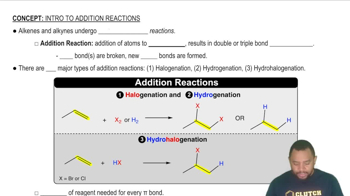Here are the essential concepts you must grasp in order to answer the question correctly.
Alkene Structure
Alkenes are hydrocarbons that contain at least one carbon-carbon double bond (C=C). This double bond is a key feature that influences their reactivity, making them more reactive than alkanes. The presence of the double bond allows alkenes to undergo various addition reactions, where atoms or groups are added across the double bond, resulting in the formation of new compounds.
Recommended video:
Addition Reactions
Addition reactions involve the addition of atoms or groups to the carbon atoms of a double bond in alkenes. Common types of addition reactions include hydrogenation (adding H2), halogenation (adding X2), and hydrohalogenation (adding HX). Each type of addition reaction produces different products, depending on the reagents used and the conditions of the reaction.
Recommended video:
Markovnikov's Rule
Markovnikov's Rule is a principle that predicts the outcome of certain addition reactions involving alkenes. It states that when HX is added to an asymmetric alkene, the hydrogen atom will attach to the carbon with the greater number of hydrogen atoms already attached, while the halide (X) will attach to the carbon with fewer hydrogen atoms. This rule helps in determining the major product of the reaction and is crucial for understanding regioselectivity in alkene addition.
Recommended video:



